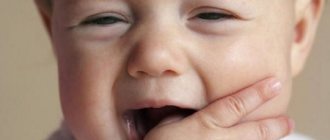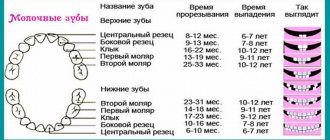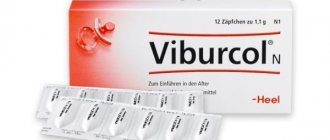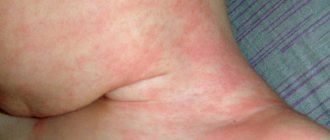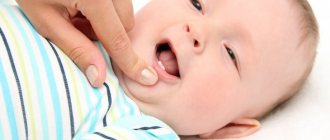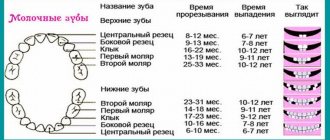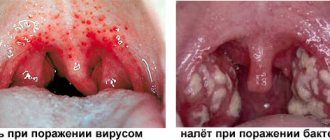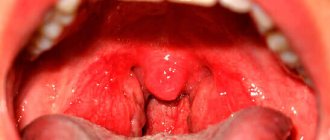Signs of teething
Most often, teething in infants begins earlier 2-4 weeks before they emerge from the gums and is accompanied by various symptoms and signs:
- Restlessness during sleep.
- Runny nose with clear, watery fluid.
- Redness of the throat.
- Decreased or lack of appetite.
- Constant scratching of the gums and excessive salivation. The child begins to put everything in his mouth.
- Increase in temperature from subfebrile to pyretic (37-40°C).
- Capricious behavior (crying, lethargy, restlessness, irritation).
- Biting the mother's breast or pacifier.
- The gums become red and swollen. Sometimes a white or purple stripe appears at the site of the future tooth; this will indicate the appearance of the tooth in the next few days.
- Diarrhea, vomiting.
- Regurgitation.
- An unpleasant odor from the oral cavity of a baby is a rare sign, but occurs when an infection occurs during this period.
Signs may be mixed or absent altogether. Some children exhibit 1-2 signs just before the tooth emerges from the gums.
Video from an expert:
The danger of redness of the throat during this period
During teething, the baby's body weakens and becomes vulnerable to pathogenic bacteria or colds.
When a baby is teething, the child endlessly puts various objects into his mouth, which are not always sterilely clean. It introduces an infection and hyperemia of the tonsils occurs (tonsillitis, pharyngitis, sore throat occur), this is a very dangerous disease for such young children.
If some symptoms intensify and last more than 2-3 days (fever, red sore throat, runny nose with yellow or green discharge, cough or wheezing in the chest), you should consult a pediatrician.
Redness in the throat of a baby may be a sign of diseases:
- mechanical, thermal damage;
- tonsillitis;
- pharyngitis;
- laryngitis;
- tonsillitis;
- allergic reaction;
- ARVI;
- acute respiratory infections;
- diseases of the stomach, esophagus;
- problems with the nasopharynx.
How can I help my baby?
During this period, the child needs maximum attention, kindness and affection from the mother - this is the best way to calm down.
To relieve pain, there are special gels, ointments, syrups, drops:
- Kalgel;
- Dentokind;
- Holisal;
- Pansoral “First teeth”;
- Kamistad Baby gel;
- Dentol;
- Dentinox-gel;
- Nurofen syrup;
- Panadol syrup;
- Dantinorm drops;
- Viburkol (suppositories);
- Baby doctor "First teeth".
When using any of the products, you must consult your pediatrician and read the instructions.
It is important to carefully monitor the child’s behavior after using the drug and examine for allergic reactions. If they occur, the drug is discontinued.
There are several more ways to help the baby overcome this difficult period:
- Massage the gums (to do this, wash your hands well with soap, wrap a sterile bandage around your finger, moisten it with warm, boiled water or a decoction of herbs).
- Massage using a teether, rubber toy, toothbrush for babies.
- Massage using a whole apple or carrot, but this method requires additional attention for the child so that he does not bite off a large piece that can get stuck in the respiratory tract.
- It is necessary to reconsider the child’s diet, add more foods containing calcium (cheese, milk, cottage cheese).
Help needs to be comprehensive, then there will be a chance to overcome the teething period unnoticed by the baby and parents.
Video from Dr. Komarovsky:
If your throat is red, there is a runny nose and fever, then you should use antipyretics:
- Panadol;
- Paracetamol;
- Ibuprofen;
- Nurofen;
- Viburcol;
- Analdim;
- Tsefekon D.
It is important to strengthen the immune system during this period, then the disease will pass faster and without complications.
The following tools are suitable for this:
- Viferon;
- Anaferon;
- Arbidol;
- Wilosen;
- Taktivin.
To cleanse the nose and treat a runny nose, sprays, drops, and solutions are used:
- Nazivin;
- Naphthyzin;
- Otrivin;
- Rhino Stop;
- Rinofluimicil;
- Sinupret.
To eliminate redness in the throat, sprays, solutions, and wiping with a cotton swab or gauze are used.
For rubdowns:
- Miramistin;
- Chlorophyllipt;
- Furacilin.
For treatment:
- Orasept;
- Inhalipt;
- Neo-Angin;
- Bioparox;
- Hexoral;
- Lysobacter;
- Lugol.
Traditional methods:
- For babies, rubs made from chamomile, mint, and sage are used. Make a decoction with 500 ml of water, choose one of the medicinal herbs - 1 tbsp. l. and boil for 5-10 minutes. Warm broth is taken into a glass and rubbed on the throat 3-4 times a day.
- Rubbing the gums and throat with a soda solution is effective.
- For children over 1 year old, use rinsing the mouth with a solution of propolis and honey, decoctions of mint, sage, lavender, St. John's wort, and valerian.
- Drinking tea with linden blossom and honey, raspberry and currant jam will have an antipyretic effect.
Video from Dr. Komarovsky about the first teeth:
The main thing for parents during this period is to be patient and not get annoyed by another hysteria or crying. Everything will pass with time, this is a natural process.
How to remove a red throat and runny nose in infants Komarovsky
During this period, the child needs maximum attention, kindness and affection from the mother - this is the best way to calm down.
To relieve pain, there are special gels, ointments, syrups, drops:
- Kalgel;
- Dentokind;
- Holisal;
- Pansoral “First teeth”;
- Kamistad Baby gel;
- Dentol;
- Dentinox-gel;
- Nurofen syrup;
- Panadol syrup;
- Dantinorm drops;
- Viburkol (suppositories);
- Baby doctor "First teeth".
When using any of the products, you must consult your pediatrician and read the instructions.
It is important to carefully monitor the child’s behavior after using the drug and examine for allergic reactions. If they occur, the drug is discontinued.
There are several more ways to help the baby overcome this difficult period:
- Massage the gums (to do this, wash your hands well with soap, wrap a sterile bandage around your finger, moisten it with warm, boiled water or a decoction of herbs).
- Massage using a teether, rubber toy, toothbrush for babies.
- Massage using a whole apple or carrot, but this method requires additional attention for the child so that he does not bite off a large piece that can get stuck in the respiratory tract.
- It is necessary to reconsider the child’s diet, add more foods containing calcium (cheese, milk, cottage cheese).
Help needs to be comprehensive, then there will be a chance to overcome the teething period unnoticed by the baby and parents.
If your throat is red, there is a runny nose and fever, then you should use antipyretics:
- Panadol;
- Paracetamol;
- Ibuprofen;
- Nurofen;
- Viburcol;
- Analdim;
- Tsefekon D.
It is important to strengthen the immune system during this period, then the disease will pass faster and without complications.
The following tools are suitable for this:
- Viferon;
- Anaferon;
- Arbidol;
- Wilosen;
- Taktivin.
To cleanse the nose and treat a runny nose, sprays, drops, and solutions are used:
- Nazivin;
- Naphthyzin;
- Otrivin;
- Rhino Stop;
- Rinofluimicil;
- Sinupret.
To eliminate redness in the throat, sprays, solutions, and wiping with a cotton swab or gauze are used.
For rubdowns:
- Miramistin;
- Chlorophyllipt;
- Furacilin.
For treatment:
- Orasept;
- Inhalipt;
- Neo-Angin;
- Bioparox;
- Hexoral;
- Lysobacter;
- Lugol.
Traditional methods:
- For babies, rubs made from chamomile, mint, and sage are used. Make a decoction with 500 ml of water, choose one of the medicinal herbs - 1 tbsp. l. and boil for 5-10 minutes. Warm broth is taken into a glass and rubbed on the throat 3-4 times a day.
- Rubbing the gums and throat with a soda solution is effective.
- For children over 1 year old, use rinsing the mouth with a solution of propolis and honey, decoctions of mint, sage, lavender, St. John's wort, and valerian.
- Drinking tea with linden blossom and honey, raspberry and currant jam will have an antipyretic effect.
The main thing for parents during this period is to be patient and not get annoyed by another hysteria or crying. Everything will pass with time, this is a natural process.
Teething is a difficult test for a child’s body and this condition is accompanied by various side effects; The nasopharynx is often an indicator of the disease process. It is important to be able to distinguish whether it is teething or an infection.
Dr. Komarovsky is not a supporter of drug treatment, for this reason he advises against taking special measures to combat inflammation associated with teething. The cause of a runny nose in a baby during teething may be increased activity of the glands in the nasal passages.
If there is discomfort or nasal congestion, Komarovsky advises using vasoconstrictor drops, saline solutions, and an aspirator to remove mucus. For a sore throat in a baby, if the gums are swollen, the doctor recommends gargling with herbal decoctions and warm drinks.
What are baby teeth used for?
How does a child cut teeth?
Teeth eruption and replacement
Why you need to treat and protect baby teeth
On the second day my daughter’s temperature jumped to 38.4. Typically, if I apply the gel, it drops to 37.4, then over time it rises again. Yesterday, as soon as I got up for the first time, we immediately went to the clinic. The doctor looked at me, said, “teeth, but my throat is red,” and sent me home. They gave my daughter Ibuprofen in the evening, she slept all night without a fever. And it wasn't until lunchtime. Then the doctor came, looked again and said again that my throat was red and prescribed us an antibiotic. Like, if the temperature rises again, then start giving. And now I’m at a loss: I really don’t want to give an antibiotic, since the beginning of the year I’ve already taken it three times. The temperature keeps jumping from 38.0 to 37.4. But my daughter is alive, eats everything, even plays, all the symptoms of teething: saliva, and chews on everything, and is capricious. What to do? Is it worth watching for another day or not? Has anyone else had a red throat when teething?
Can there be a cough during teething in children (Komarovsky)
Teething is a difficult time that parents have to face sooner or later. This period passes differently for everyone, for some children they come out painlessly and unexpectedly, for other children their incisors come out with pain, hysterics and poor health.
Can there be a cough during teething?
As a rule, when teeth come in, children’s immunity is weakened, so along with their appearance the following signs of illness may appear:
- runny nose;
- cough;
- sputum discharge;
- red throat;
- hoarse voice;
- wheezing in the throat;
- temperature;
- poor appetite;
- sleep disturbance.
Many parents are interested in the question of whether there can be a cough during teething. Reply #8212; positive. This symptom often appears, but you should not think that it is obligatory; there are many children whose appendages come out painlessly.
Cough during teething in children occurs for the following reasons:
- nasal congestion;
- salivation that accumulates in the larynx;
- hidden disease that has nothing to do with the appearance of incisors;
- long-term cold.
Also, all the signs mentioned above can appear during the eruption of molar processes. Most often, teeth hurt during sleep and symptoms of the disease appear at night.
What kind of cough occurs in children during teething?
Many people are concerned about the question of what kind of cough is possible when teeth are being cut. In fact, it can be anything: dry, wet or wet (with phlegm). None of these types require treatment, because medications can only progress the disease.
Wet occurs due to phlegm and saliva accumulated in the throat - for these reasons, hoarseness appears. Children may also cough up accumulated mucus several times during the day.
As a rule, this type of symptom lasts no more than 3 days. If it becomes severe, and shortness of breath and wheezing appear, the help of a doctor is needed, as these are signs of complications of the cold.
Dry #8212; in infants it occurs after prolonged crying, due to the fact that there is dryness in the throat, the baby begins to cough. Such phenomena last no more than two days. If your baby's voice is hoarse, don't panic ahead of time - this is within normal limits.
If you are interested in why a baby hiccups in the womb, simply click here. After all, the causes of intrauterine hiccups in a baby can be due to various reasons.
How to remove a red throat and runny nose in infants (Komarovsky)
Of course, many parents begin to worry about their baby getting sick and wonder how to treat it. No special approach is required, you just need to spend as much time as possible with him and constantly distract him from the aching pain.
Snot during teething occurs for various reasons, one of the common ones is increased activity of the glands in the nasal passages. Usually, a child does not develop a runny nose, but so-called mucus, which secretes for up to 4 days. If it causes discomfort, then you should use vasoconstrictor drops. You can also use an aspirator to remove your baby's mucus or snot.
If you don’t know whether nasal congestion can occur from teeth, you can watch the video at the end of the publication, in which Dr. Komarovsky talks about how these phenomena are related. To relieve a baby's throat pain, you need to gargle with herbal infusions and drink warm teas. You can read recipes on the forum, ask a doctor, or use your own experience.
In order to get rid of accumulated mucus in the nose, it is recommended to use AquaMaris in the form of drops or spray. It is recommended to use this drug 3-4 times a day, especially since sea water is completely safe.
Read useful articles:
Alena * Tashkent . In my opinion, it is better to solve such problems as they arise. Nothing significant is bothering the child right now—it’s worth getting by with minimal effort—cool, moist air, plenty of fluids, minimal food, perhaps multivitamins. Now I can handle the situation much more calmly when a child has a runny nose - the most I can do is rub the feet at night with a warming ointment, or warm them in a bath with pine extract (plus the regimen described above). I’ve just had my own observations a couple of times already - I don’t overdo it with treatment, especially in the future - everything goes away by itself, I start fussing - I get the full package: nasopharyngitis, fever, seriously and for a long time. And it’s difficult to check - would it have been like this if I had left her alone, to fight on her own?
assistant moderator Messages: 9061 Registered: Fri Jul 27, 2007 16:02 From: Sillamäe, Estonia Thanked: 22 times Thanked: 19 times Contact information:
The child is one year and 7 months old, today we went to kindergarten and he was taken out with a red throat. How can you cure a sore throat in 3 days? I don’t want to sit on sick leave, and when we approached the apartment the child got hysterical and didn’t want to go home, he’s very much in kindergarten. like
Messages: 1234 Registered: Mon Mar 28, 2005 11:03 From: Kaliningrad Thanked: 1 time Contact information:
latiffa . Is there anything besides the red neck? Last week we also left the kindergarten with sniffles and a red throat, but it was still warm. The doctor prescribed an inhalant for the throat. It’s better to stay at home and wait for a full recovery.
Messages: 99 Registered: Sun Dec 02, 2007 12:58 From: Ivanovo, Russia
Hello. and we have such a problem. Yesterday afternoon I fed the babies (9 months) kefir + cottage cheese + fruits from the refrigerator. After dinner (vegetable puree), the boy started vomiting half an hour later, then pooped liquid. The girl is fine. An hour after the last feeding (formula), the boy vomited again. And at night the temperature rose to 39 and again he pooped loosely. I gave him an antipyretic (Efferalgan), the temperature dropped, and the boy slept almost peacefully until the morning. In the morning the temperature rose again to 38.1, I drank some water and pooped loosely again. I called the doctor. The doctor said that the baby has a very red throat and swollen gums (teeth are creeping out). And that vomiting and loose stools are precursors, and then the result of high fever. And she prescribed an antibiotic - amoxicillin in suspension. I don’t know what to do, I don’t want to give my baby antibiotics
Red throat during teething
Over time, every child begins to teethe; this is a crucial moment not only for him, but also for his parents, who are often too worried about this natural process.
There is nothing terrible about it, the main thing is to prevent the development of diseases that have a negative connotation and cause inconvenience and pain to the baby. I believe that you can still save a lot on visits to the dentist. Of course I'm talking about dental care. After all, if you carefully care for them, then treatment may indeed not come to pass - it won’t be necessary. Microcracks and small caries on teeth can be removed with regular toothpaste. How? The so-called filling paste. For myself, I highlight Denta Seal. Try it too.
One of the unpleasant ailments is a red throat, difficult to distinguish with the naked eye, but it does exist. With this problem comes pain, which is not one of the teething symptoms. The throat is negatively affected by cold air or infections that try to enter the body from the outside.
This may cause redness in the said area, which does not lead to anything. If your child's breathing is irregular or the throat is swollen, contact your pediatrician.
Below we will consider in detail the factors that negatively affect the baby’s health, which is why redness appears.
Causes of red throat
This disease is not an independent disease; it acts as a symptom that provokes the development of various diseases. The most common causes of redness include:
- infectious diseases such as laryngitis, sore throat, pharyngitis, etc. Scarlet fever is considered the most dangerous disease, causing serious consequences. It is characterized by signs in the form of a crimson tongue, redness of the throat and rashes spreading throughout the body;
- a consequence of the flu, and if the disease occurred in a latent form, then you should first get rid of it and its complications;
- fungal infection is a rare occurrence, but if it occurs, you must first find out the origin of the disease, and then choose an effective course of treatment by choosing the right medications;
- an allergic reaction is accompanied by swelling of the mucous membrane of the oropharynx and respiratory tract, salivation increases, and a mucous mass begins to flow down the back wall of the pharynx;
- Injury to the pharynx and throat – scratches were noticed that appeared as a result of improper oral care, when swallowing small objects.
Not only redness is a consequence of the growth of incisors or fangs, during this process the following problems can be observed:
- poor sleep and lack of appetite;
- excessive salivation;
- depression, loss of strength;
- excessive moodiness;
- swelling and hyperemia of the gums, turning blue.
When it is possible to identify the cause of the redness, then it is easier to prescribe treatment and get rid of the disease.
The main thing is not to try to independently determine what caused the problem, since an incorrect diagnosis may be made. Only a specialist is able to draw the right conclusions after examination by drawing a clinical picture.
What to do in this case?
When teething, there is no need to look for any special method of care, since in such a case attention from parents will help. They should spend more time with the child, distract him from pain, turning his attention to other things.
When the baby experiences severe discomfort, which is unusual in most cases during teething, then treatment with immunomodulatory and antimicrobial agents is prescribed.
You can benefit from the following methods to relieve your throat:
- rinsing is carried out in the mouth and throat for preventive and therapeutic purposes, acting against infections and pain during teething. A decoction of sage and chamomile works well, and you can also notice a positive effect from saline solutions. The procedure should be carried out 30 minutes before meals or the same amount after meals;
- Lubricating the throat will help get rid of inflammation that is bothersome during infectious diseases. Thanks to this therapeutic method, the pain is dulled and then completely disappears. For lubrication, the best means are a solution of Chlorophyllipt and Miramistin, available in the form of a spray. Sea buckthorn and propolis oil also have a beneficial effect on the throat. To carry out the procedure, you will need a cotton swab soaked in the healing liquid. It is necessary to carry out each course 30 minutes before a meal or the same amount after it.
Do you feel nervous before visiting the dentist?
Specific medications are prescribed depending on the origin of the throat disease. For example:
- antibiotics are prescribed for infectious diseases or after establishing the irritant and its susceptibility to the drug;
- antiviral agents such as Viferon, Laferobion, etc., will help eliminate viruses that have entered the body;
- antihistamines such as Zyrtec, Zodak, Claritin syrup, etc., relieve swelling visible in the tissues of the throat and nose, they prevent the allergic reaction from stopping;
- glucocorticosteroids are prescribed in the form of a solution injected in severe cases;
- Faringosept and Strepsils tablets, which dissolve, will be useful. Since there are age restrictions, you first need to read the instructions in detail or the best option would be to consult with a specialist.
It will not be superfluous to use traditional medicine, which has proven itself to be one of the most effective types of treatment. To make your baby feel better during teething, choose the following:
- in addition to the mentioned chamomile decoction, honey is useful, but before using it, you should establish a possible intolerance to the product;
- a decoction made from valerian roots will relieve inflammation;
- teething is easier if you massage your gums with special rubber toys in the form of fruits and vegetables.
Expert advice
The famous doctor Evgeny Komarovsky expressed his competent opinion on ways to eliminate red throat and runny nose in infants, where he opposes treatment with medications.
Not being a supporter of this method, the doctor recommends stopping the use of medications. Although medications have been developed that are aimed at relieving inflammatory processes during teething, this method is not one of the most gentle.
A runny nose may appear in a baby due to the hard work of the glands in the nasal cavity, which worsens the baby’s health. If a child experiences negative problems such as nasal congestion and discomfort, then Dr. Komarovsky strongly recommends using drops that constrict blood vessels; saline solutions or an aspirator that eliminates mucus are also suitable.
When a baby’s throat begins to hurt and the gums swell, the best option to get rid of the disease is to gargle with herbal decoctions and drink warm liquid.
The safest drink that does not contain dyes and other harmful substances is mineral water. It can be used for inhalation, and it will not cause any harm to children under 1 year of age.
Redness of the throat is an alarming signal indicating the possible occurrence of serious diseases, so do not delay a visit to a specialist. If you provide help to your baby in a timely manner, this will protect him from deteriorating health without causing negative reactions in the body.
Source: https://zub.expert/polost-rta/krasnoe-gorlo-pri-prorezyvanii-zubov
Can babies have a runny nose when teething?
The development of teeth in a child begins while he is still in the womb, where the development of tooth buds in the gums of infants occurs. It is a very common belief that a baby’s teeth should appear only in a strictly defined sequence and only at a certain age. In fact, there is neither a strict order nor a strict distinction by age. For all babies this happens strictly individually and depends on many factors. That is, the appearance of teeth in children is as individual as weight gain, growth, and development. Return to content
Timing and order of teething
Timing and order of teething
Naturally, there are certain general trends in teething; for most children, their first teeth appear at approximately 4-7 months. Deviations, up or down, should under no circumstances worry parents. In general, the lower and upper incisors appear first, then the second incisors, the first molars, the canines, then the second molars. The order in which teeth appear in each baby may also be different. By about three years of age, each child becomes the owner of a row of 20 baby teeth, which remain (with proper care) until he is 6-7 years old, after which they begin to be replaced by permanent teeth. Return to content
First signs of teething
First signs of teething
The symptoms accompanying the process of teething in infants are as specific as the timing and age of teething. So some children endure teething absolutely easily and painlessly, while their happy parents discover teeth completely by accident. In other children, teething is painful and is accompanied by various conditions that cause discomfort for the baby. Soreness and swelling of the gums, increased salivation - these are the symptoms that appear in children a month or two before teething (this period may be shorter). Children begin to be disturbed by these factors, resulting in anxiety, irritability, and disturbed sleep and appetite. The gums begin to itch, and in response, the baby begins to put everything in his mouth. Closer to the moment when the tooth appears, a small whitish spot, a whitish line, or a thin white protrusion appears on the gum. Return to content
Other signs
teething in infants
Some children experience teething with symptoms such as cough, runny nose, vomiting, diarrhea, and fever. Doctors differ on whether such symptoms are truly teething symptoms. But, despite this, the connection between the change in the baby’s condition and teething is obvious. A slight increase in temperature during teething is associated with a decrease in the child’s immunity during this period. The temperature during teething should not last more than two days. Diarrhea and vomiting can be associated with excessive salivation when the baby's intestines cannot cope with large amounts of saliva. Watery, infrequent diarrhea for 1-2 days during teething is normal. Return to content
Cold or teeth?
redness in the throat during teething of infants
A runny nose and cough are symptoms mainly of colds. Can babies have a runny nose and cough when teething? How not to confuse these symptoms with a cold or flu? Teething in infants and snot is a completely understandable process. The appearance of a runny nose, nasal congestion, and nasal discharge during teething is associated with the secretion of excess mucus by the glands located in the nasal cavities. This is explained by the fact that during the period of teething, the baby’s immunity decreases, as a result of which these glands begin to work as a protective function of the body. Therefore, if you answer the question: does teething cause snot in babies? We can answer that in some cases, undoubtedly. During this period, nasal discharge is watery, a runny nose is characterized by the appearance of clear, runny mucus, not very abundant. Usually, if teething causes a runny nose in infants, it lasts no more than 3-4 days and does not require special treatment. The only thing parents should do is to regularly clean the nasal cavities. The appearance of a greenish or whitish purulent runny nose, accompanied by severe nasal congestion, and its persistence for more than 3 days is a symptom of a disease not associated with teething; the child must be shown to a doctor. Cough teething in infants can be explained by a large accumulation of saliva in the baby’s mouth. The cough during this period is characterized by a wet, rare manifestation, worsening in the lying position. The symptom of cough during teething in infants usually goes away in 2-3 days and does not require any special treatment. Frequent cough with sputum, mucus, accompanied by wheezing, shortness of breath, persisting for more than 2 days is a manifestation of the disease; again, the child must be shown to a doctor. Another “tricky” point is redness in the throat during teething in infants. Often parents are afraid of him. However, it is quite understandable, since the process of teething is associated with the fact that the blood supply to the entire oral cavity increases - as a result, the throat turns a little red. This redness goes away quickly. Doctors recommend that inexperienced parents, if they have a cough, runny nose, red throat, or fever, call their doctor at home in any case, since all these signs can be associated with other diseases that appear in the baby at this age.
Sources: No comments yet!
Teething is a difficult test for a child’s body and this condition is accompanied by various side effects; The nasopharynx is often an indicator of the disease process. It is important to be able to distinguish whether it is teething or an infection. Regardless of the root cause of the ailment, especially if the child has a red throat during teething, the help of a specialist is necessary.
Red throat during teething in children: how to treat, what to do
Teething is a difficult test for a child’s body and this condition is accompanied by various side effects; The nasopharynx is often an indicator of the disease process. It is important to be able to distinguish whether it is teething or an infection. Regardless of the root cause of the ailment, especially if the child has a red throat during teething, the help of a specialist is necessary.
Timing and order of teeth appearance
The appearance of the first teeth in children occurs between six months and one and a half years. And by the age of three, a child has about 20 of them. So, the first, at 6-10 months, are the lower central incisors, followed by the upper central incisors.
Next, the upper and lower lateral incisors erupt. Thus, by the age of one and a half years, there are already 8 incisors present. Afterwards, the first molars begin to grow, then the canines, and finally the second molars.
A baby's teeth should appear only one at a time, but sometimes they appear simultaneously.
First signs of teething
The first general signs of teething in infants may also indicate the presence of a cold or infection, as well as changes in environmental conditions.
These include: anxiety, sleep disturbance, general malaise, weakness, loss of appetite, fever.
Local symptoms include: excessive salivation, swelling and redness of the gums, slightly red root of the tongue, breast refusal, the child puts fingers, fists, toys in his mouth, less often there is slight nasal congestion, red throat.
Teeth and problems during teething
Since teething is not an easy process for a small organism, it can significantly reduce immunity.
As a result, the child may have an increase in body temperature, abnormal stool, increased anxiety, tearfulness, moodiness, and unpleasant diseases such as thrush, stomatitis, and caries may appear.
The symptoms that appear may indicate either inflammation or an infectious disease.
Cold or teeth
How to figure out whether a child has a cold or teeth? Determining what is the source of a baby’s teething discomfort is not easy. But there are some signs of the disease:
- loose, foamy, unpleasant-smelling stools;
- profuse snot, accompanied by lacrimation, and acute pain in the throat;
- severe fever or fever lasts more than two days
In all these cases, you should immediately consult a doctor.
In cases where the temperature lasts no more than two days, the stool changes, the snot is slight, even with some nasal congestion, the throat is red, and all this is accompanied by profuse salivation - most likely the reason is teething. In this case, antibiotics will not help, but will only worsen the situation.
Colds and hypothermia
Colds occur as a result of decreased immunity. It manifests itself as inflammation of the upper respiratory tract, and often resolves under the influence of a chronic bacterial infection on the body; but also a common cause of colds is hypothermia.
Inflammation of the tonsils, adenoids
The throat is red - could this be an infectious inflammation, and how to distinguish between these conditions? Tonsillitis, or inflammation of the tonsils, manifests itself in two forms - acute and chronic; it often occurs in conjunction with chronic adenoiditis, inflammation of the adenoids.
The symptoms of both conditions are easy to distinguish from the teething condition: fever, bad breath, whitish plaque on the tonsils, pain and redness in the throat, difficulty swallowing and breathing, against the background of proliferation of lymphoid tissue and narrowing of the respiratory lumen.
Allergy
Cytokine surge, or allergic rashes during the eruption of baby teeth. Teething is stressful for a child, his nervous system experiences increased stress, against this background the immune system is weakened, and the body responds either by developing infectious conditions or by decreasing resistance to chemicals and hygiene products.
For allergic rashes, air baths, daily hygiene of problem areas and care using special antihistamines are indicated.
Infections
The main rule for distinguishing an infectious disease from teething is to monitor the timing of elevated temperature and accompanying conditions (diarrhea, irritability, snot, redness of the throat, etc.).
If the temperature persists for more than two days, or white plaque or blisters appear on the tongue, gums, or lymphoid tissue, it is time to consult a doctor to avoid possible complications and exclude symptoms of a disease not related to teething.
Treatment
No special care is required during teething. It is important to spend more time with the child, distracting him from the constant aching pain. In exceptional cases, symptomatic treatment is used, for example, the use of antimicrobial and immunomodulatory drugs.
Rinse
Mouth and throat rinses are used both for the prevention and treatment of infectious diseases, and to relieve pain during teething. For this, it is recommended to use decoctions of sage, chamomile, and saline solutions. It is advisable to rinse thirty minutes before or thirty minutes after meals.
Lubricating the throat
Lubricating the throat is used to relieve inflammation in infectious diseases and relieve pain during teething.
For lubrication use: Chlorophyllipt solution, Miramistin (also used in the form of a spray), sea buckthorn oil, propolis oil.
Lubrication is carried out either thirty minutes before or thirty minutes after meals, using a stick with a cotton swab at the end.
Traditional medicine to protect the baby
Traditional medicine offers its own ways to alleviate the condition of a child during teething:
- A decoction of chamomile flowers or honey (if you are not allergic to bee products) will help relieve teething pain. If you raise the head of the bed, the rush of blood during lying down will decrease and the pain will subside a little;
- You can relieve inflammation with anti-inflammatory drugs - a decoction of sage or valerian root;
- To facilitate teething, especially if the gums are very swollen, it is recommended to massage with rubber rings or vegetables (fresh carrots, cucumber) and fruits (apple, pear).
It should be borne in mind that when using one or more methods of helping your child, it is important to exclude possible contraindications.
How to remove a red throat and runny nose in infants Komarovsky
Dr. Komarovsky is not a supporter of drug treatment, for this reason he advises against taking special measures to combat inflammation associated with teething.
The cause of a runny nose in a baby during teething may be increased activity of the glands in the nasal passages. If there is discomfort or nasal congestion, Komarovsky advises using vasoconstrictor drops, saline solutions, and an aspirator to remove mucus.
For a sore throat in a baby, if the gums are swollen, the doctor recommends gargling with herbal decoctions and warm drinks.
What are baby teeth used for? How does a child cut teeth?Eruption and replacement of teethWhy do you need to treat and take care of baby teeth?
Source: https://zubi.pro/detskaya/krasnoe-gorlo-pri-prorezyvanii-zubov.html
Timing and order of teeth appearance
The appearance of the first teeth in children occurs between six months and one and a half years. And by the age of three, a child has about 20 of them. So, the first, at 6-10 months, are the lower central incisors, followed by the upper central incisors. Next, the upper and lower lateral incisors erupt. Thus, by the age of one and a half years, there are already 8 incisors present. Afterwards, the first molars begin to grow, then the canines, and finally the second molars. A baby's teeth should appear only one at a time, but sometimes they appear simultaneously.
First signs of teething
The first general signs of teething in infants may also indicate the presence of a cold or infection, as well as changes in environmental conditions. These include: anxiety, sleep disturbance, general malaise, weakness, loss of appetite, fever. Local symptoms include: excessive salivation, swelling and redness of the gums, slightly red root of the tongue, breast refusal, the child puts fingers, fists, toys in his mouth, less often there is slight nasal congestion, red throat.
Can there be a fever when teething?
Teething fever most likely indicates another health problem, such as an infection.
There are two main reasons why teething and infections occur at the same time:
- Increased exposure to new pathogens
: Between 6 and 12 months of age, infants put various objects in their mouth. This exposes the baby to new pathogens. - Antibody loss
: A baby between 6 and 12 months of age begins to lose the antibodies that the mother gave to him at birth. This means that the immune system will respond to more infections, such as colds.
To summarize, fever can occur around the same time as teething. However, fever is a sign of infection and not a symptom of teething.
Cold or teeth
How to figure out whether a child has a cold or teeth? Determining what is the source of a baby’s teething discomfort is not easy. But there are some signs of the disease:
- loose, foamy, unpleasant-smelling stools;
- profuse snot, accompanied by lacrimation, and acute pain in the throat;
- severe fever or fever lasts more than two days
In all these cases, you should immediately consult a doctor.
In cases where the temperature lasts no more than two days, the stool changes, the snot is slight, even with some nasal congestion, the throat is red, and all this is accompanied by profuse salivation - most likely the reason is teething. In this case, antibiotics will not help, but will only worsen the situation.
Colds and hypothermia
Colds occur as a result of decreased immunity. It manifests itself as inflammation of the upper respiratory tract, and often resolves under the influence of a chronic bacterial infection on the body; but also a common cause of colds is hypothermia.
Inflammation of the tonsils, adenoids
The throat is red - could this be an infectious inflammation, and how to distinguish between these conditions? Tonsillitis, or inflammation of the tonsils, manifests itself in two forms - acute and chronic; it often occurs in conjunction with chronic adenoiditis, inflammation of the adenoids. The symptoms of both conditions are easy to distinguish from the teething condition: fever, bad breath, whitish plaque on the tonsils, pain and redness in the throat, difficulty swallowing and breathing, against the background of proliferation of lymphoid tissue and narrowing of the respiratory lumen.
Allergy
Cytokine surge, or allergic rashes during the eruption of baby teeth. Teething is stressful for a child, his nervous system experiences increased stress, against this background the immune system is weakened, and the body responds either by developing infectious conditions or by decreasing resistance to chemicals and hygiene products.
For allergic rashes, air baths, daily hygiene of problem areas and care using special antihistamines are indicated.
Infections
The main rule for distinguishing an infectious disease from teething is to monitor the timing of elevated temperature and accompanying conditions (diarrhea, irritability, snot, redness of the throat, etc.). If the temperature persists for more than two days, or white plaque or blisters appear on the tongue, gums, or lymphoid tissue, it is time to consult a doctor to avoid possible complications and eliminate symptoms of a disease not related to teething.
Teething symptoms
The period of their appearance is approximately 6-8 months. But in some cases it can start much earlier or later. Also, the signs of this process differ significantly from individual to individual. Some children show with all their appearance how bad they are and truly suffer, while for others, teething occurs quickly and easily, without showing any symptoms.
Most often, parents and pediatricians note the following changes in the child’s body:
- there is restless sleep, frequent awakenings;
- the runny nose intensifies, abundant clear mucous discharge from the nose appears;
- similarly, salivation increases;
- the throat turns red;
- loss of appetite, the child often refuses breast or formula;
- the baby pulls into his mouth all objects that come to his hand and chews them intensively;
- body temperature may increase;
- restlessness and moodiness in behavior;
- upon examination, swelling of the gums and their redness are noticeable;
- Often, due to teething, diarrhea, vomiting, and frequent regurgitation appear.
All signs indicate that the child is in severe pain. Any symptoms appear for a reason. Doctors explain why this process is fraught with difficulties. The fact is that during this period the body’s immunity is significantly reduced. An inflammatory process occurs in the mouth, in which all surrounding tissues are involved.
Against this background, children can really get sick, since it is much easier for infections to penetrate into weakened organs. This is also facilitated by the fact that the child tries to gnaw on all objects, which are not always clean enough.
Therefore, parents should be especially careful, since the throat may turn red during teething for various reasons:
- cold;
- ARVI;
- stomatitis;
- inflammation of the tonsils, adenoids;
- allergic reaction;
- various bacterial, viral or fungal infections.
A doctor will help you distinguish one from the other. Let us list the symptoms that indicate that a red throat is not associated with teething, but with some disease:
- high temperature lasts longer than two days, even if it does not exceed 37.5;
- a white coating or rash appears on the surface of the gums, tonsils, and tongue;
- loose stools, foamy, with bloody discharge or a strong unpleasant odor;
- the mucus that flows from the nose has a greenish or yellowish tint and is thick in consistency;
- a cough appears, the child produces sputum;
- the throat hurts very much, it makes it difficult to swallow;
- swelling of the mucous membrane, tongue, lips is noticeable.
With such symptoms, you should not self-medicate, but should immediately contact your pediatrician.
Treatment
No special care is required during teething. It is important to spend more time with the child, distracting him from the constant aching pain. In exceptional cases, symptomatic treatment is used, for example, the use of antimicrobial and immunomodulatory drugs.
Rinse
Mouth and throat rinses are used both for the prevention and treatment of infectious diseases, and to relieve pain during teething. For this, it is recommended to use decoctions of sage, chamomile, and saline solutions. It is advisable to rinse thirty minutes before or thirty minutes after meals.
Lubricating the throat
Lubricating the throat is used to relieve inflammation in infectious diseases and relieve pain during teething. For lubrication use: Chlorophyllipt solution, Miramistin (also used in the form of a spray), sea buckthorn oil, propolis oil. Lubrication is carried out either thirty minutes before or thirty minutes after meals, using a stick with a cotton swab at the end.
Traditional medicine to protect the baby
Traditional medicine offers its own ways to alleviate the condition of a child during teething:
- A decoction of chamomile flowers or honey (if you are not allergic to bee products) will help relieve teething pain. If you raise the head of the bed, the rush of blood during lying down will decrease and the pain will subside a little;
- You can relieve inflammation with anti-inflammatory drugs - a decoction of sage or valerian root;
- To facilitate teething, especially if the gums are very swollen, it is recommended to massage with rubber rings or vegetables (fresh carrots, cucumber) and fruits (apple, pear).
It should be borne in mind that when using one or more methods of helping your child, it is important to exclude possible contraindications.
How to calm your baby during teething?
Parents can try the following methods to ease their baby's teething discomfort:
- Breastfeeding
: Continuing to breastfeed your baby will help him calm down. - Rubbing the gums
: Use a clean finger to apply gentle pressure to the gums. - Give something safe to chew
: A hard rubber teething ring can help relieve teething discomfort. Rings filled with liquid should not be given because the child may bite through them, causing liquid to enter the child's mouth. Your baby should never be left alone with any teething toy as there is a risk of choking. - If the above methods are not effective, talk to your doctor about pain medications
such as acetaminophen or ibuprofen. Never give aspirin to an infant.

